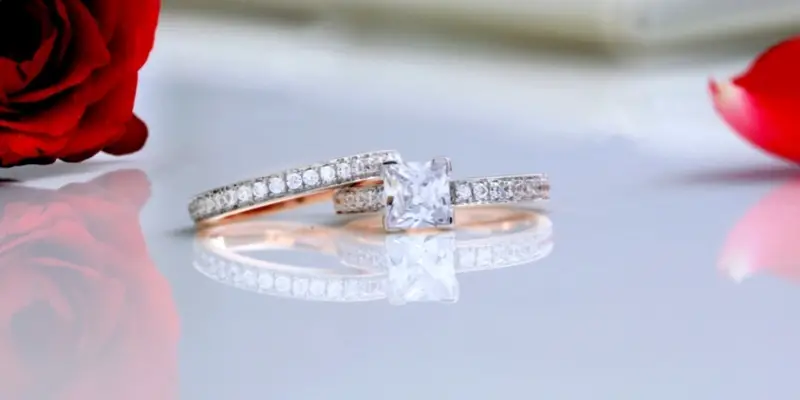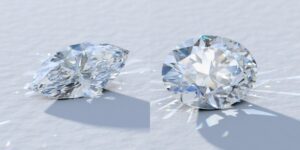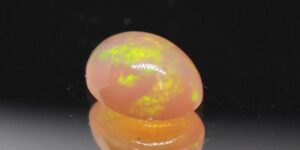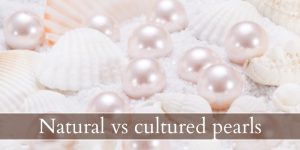Finally found that perfect diamond for your loved one ? Well, if you’re ready to pop the question soon, you’ll need to set that diamond in the perfect ring. Maybe you’ve got the metal type down already, but what about the setting ? The way you set a diamond can have a serious impact on tis overall look, how safe and snug it’s in the ring, and how big or small it may look.
Today we’re looking at the best way to set a princess cut diamond, the only thing good enough for a princess !

Best ring setting for a princess cut diamond
The best ring settings for a princess cut diamond are the ones that cover and protect the sharp corners, such as a 4-prong setting, a bezel setting (full or half), or a channel setting if going for side stones or an eternity ring. This way the princess cut’s sharp corners a re protected and you will be able to confidently wear your ring in any situation.
A princess cut’s sharp corners may look beautiful but they do need protection. Diamonds are very tough but they can be broken with the right amount of forge applied in the correct spot. And that correct spot is any sharp angle, like a princess cut’s sharp corner, or a pear’s point, or the girdle of a round cut. The proper setting will ensure your diamond won’t suffer.
Let’s go over each of these setting styles and see how they differ, their strong points, and which would be best for which scenario.
4-prong setting for a princess cut
The 4 prong setting is perhaps the most common setting, especially for a princess cut. This setting has 4 prongs reaching up from the band and onto each of the princess’ corners. This way the sharp 90 degree corners of the princess are covered by metal, so they won’t hit anything directly.
Pros of a 4-prong setting:
- allow in plenty of light for brilliance and fire
- cover the 4 sharp corners, offer protection without looking bulky
- allow for a high profile setting if that is what you like
Cons of a 4-prong setting:
- only protect the 4 corners, may allow the girdle to be hit
- difficult to get a low-profile setting
- may snag onto fabric, like any prong setting
Now, these prongs can be plain, as in just prongs, or they can be V prongs that go down the side of the corners a little. Whichever style you choose, your princess will be safe.
Bezel setting (half or full)
A bezel setting, in its full form, is a band of metal that goes all around the diamond’s girdle, covering a bit of the crown and the pavilion. Sometimes it covers all of the pavilion, and goes down to the ring band (like a tube of sorts). A half bezel only covers two sides of the diamond, and this includes all 4 corners.
Pros of bezel setting:
- extra secure, there is no safer way to set a diamond
- can be a low setting if you need it
- will not snag, even the half bezel won’t
- offers a beautiful border effect for the diamond
Cons of a bezel setting:
- may appear too bulky for some
- completely blocks light from entering the pavilion (expect the half bezel)
Channel setting
A channel setting mean the diamond is set in a row (or channel) on the ring band itself, with the edges completely covered by the ring metal. Think of it like an elongated half bezel. This setting type covers all the corners of the princess, and sets it flush against other princess diamonds (or baguettes).
This setting type is most common in eternity rings, half-eternity, and in very low profile rings such as a very low cathedral or a tension setting.
Pros of channel setting:
- diamonds are fit snugly, will not easily fall out
- form a beautiful sparkling row
- will not snag, unlike a pave
- diamonds are low-set, will not take a direct hit
Cons of channel-setting:
- difficult to use as center stone setting
- may dull or darken the diamonds (less light)
- may look bulky for some
- if a diamond falls out, the rest may wiggle out
Is color of clarity more important for princess diamonds ?
Princess cut diamonds are a brilliant cut style, as such they hide both color and inclusions very well. But the corners of a princess cut are very shallow, and any imperfection present there will be immediately noticeable. So for princess diamonds clarity is more important than color, and you should check the corners of a princess very thoroughly.
Also be sure there isn’t any color accumulation in the corners as well. This can happen with some diamonds, regardless of the color grade. Sometimes the way the diamond is cut can make the tips appear warmer, and this can also happen if the diamond’s natural color is concentrated on one side.
We recommend always looking at several princess diamonds that fit your needs (carat, color, clarity, cut quality) and analyze them form every possible angle, and in any light setting, including diffused light and bright spotlights.
Read also: Best Metal For Engagement Rings
How can you make a princess cut diamond look bigger ?
A princess cut diamond can look bigger in a halo setting, a milgrain bezel setting, or set on its point (diagonal setting). All three options provide the optical illusion that the diamond is larger than it actually is. The most common option is the halo setting.
Let’s take a look at each illusion and see how it would work.
Halo setting
The halo setting is very well known. This setting has a row of tiny diamond surrounding the center diamond, offering extra sparkle and make the center diamond appear larger as well, unless you’re looking very, very closely. This illusion works best when the setting metal color is the same as the diamond color.
Milgrain bezel setting
This setting is a bezel setting that has been worked to have tiny little beads all around it. They are tiny, but have a similar effect to a halo setting, in that they appear to glitter like a diamond (but show no fire, only brilliance). Unless you’re looking very closely you won’t easily notice that it’s metal, not diamond.
And of course, this only works if the metal for the bezel setting is the same color as the diamond (so a white for a white diamond, rose gold for a pink diamond, yellow gold for a champagne or yellow diamond).
This style doesn’t add as much as the halo in terms of extra millimeters, but it does add about 1 mm per side.
Diagonal setting (or kite)
The diagonal setting is exactly what it sounds like. Take your princess diamond, turn it on one of its points (assuming you have a 1:1 or 1:1.05 ratio princess) and it will look like a kite. This setting style can be used in conjunction with either the milgrain bezel or the halo setting and look even better.
In a way the diagonal setting may remind you of a marquise setting, with a sharp looking angle. This is not an easy look to wear, and may need a special wedding ring to accommodate the shape. Still, it’s a fresh new take on a classic.
Are princess cut diamonds out of style ?
No, princess diamonds are not out of style, in fact they are the second-best selling diamond shapes, right after the round cut. So these diamonds are definitely still a popular choice. Don’t worry about having an outdated ring, or getting your fiancee an outdated ring. Trends come and go anyway, so customizing your engagement ring to fit a certain trend is pointless, it will be dated in 10 years.
If you really like the look of a princess cut diamond, get that diamond. Don’t let someone tell you it’s going out of style or so yesteryear. As childish as it sounds, those people are usually just jealous.

I’m the main author for jewelrymaterialguide.com. I started this site after we did tons of research before our wedding and noticed that there is information about rings, jewelry, and so on that is really hard to find on the internet.






